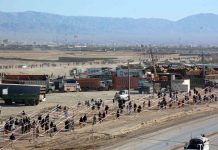FAIZABAD (Pajhwok): “Following her death, my life has become very bitter and my mind extremely vacuous. I don’t know whether I should eke out a living for my family using a handcart or sit at home to look after my children.”
Khair Mohammad, whose house is located just three kilometres from the civil hospital in the provincial capital, lost his spouse on the way to the medical facility. Expecting a baby, the woman died of excessive bleeding.
Pushing his handcart, the palpably distraught man told Pajhwok Afghan News he had received cash from someone to treat his wife. However, to his chagrin, Mohammad’s life-partner breathed her last close to the civil hospital.
Since the passing of his 28-year-old wife, the manual worker has been in trouble looking after his six children. The impoverished man has stopped pushing and pulling the cart — his principal source of income. “My two-year-old-son needs milk, but I’m penniless.”
Mohammad, 35, has no option but to stop sending his elder son, a student of Class 1, to school. After dropping out, the boy will take care of four sisters and a brother. Additionally, he will have to work to supplement his father’s income!
“If there were a clinic close to our home, my wife may have survived,” argued the daily-wager, who explained Faizabad dwellers were not alone in being hit by the absence of a maternal health centre. In fact, all residents of Badakhshan are facing the problem.
A midwife at the Baharak Health Clinic, Maleeha, said an expecting mother had a miscarriage on her way to the facility. The woman, who was being transported to the clinic on a mule, lost her baby due to the lousy route and bleeding. Doctors took great pains saving her life.
The medic confirmed many expecting mothers from remote districts like Baharak, Arghanchkhwa, Yamgan and Kiran-o-Manjan districts died while being brought to hospital.
She added: “There are villages, from where patients are transported to district clinics on horses and mules in two days. The number of child and mother mortalities is higher that registered cases, as many women and their babies dies on the way.”
Ex-chairman of provincial council Abdul Wahid Tayyebi, a resident of Khwahan district, spoke of three expectant moms’ deaths in the Hawaz Shah area in the past three years. Such deaths generally occur in the winter when snows close link roads.
There is one clinic each in the district centre and the Hawaz Shah locality, according to Tayyebi, who said the rural facility had a midwife and a nurse. The two staffers could not meet the needs of scores of patients, he argued.
At times, he pointed out, patients were taken from Khwahan to Faizabad, covering a distance of 6o kilometres. More often than not, the ex-public representative complained, women and their babies died on the way to the provincial capital.
The government should launch mobile health clinics to treat expecting mothers in far-flung areas, Tayyebi suggested, claiming he had taken up the issue several times with public health officials. However, no step has been taken yet to address the problem.
On the other hand, authorities say heal clinics are operational in all district centres — some of them too far from villages. The sheer distance, they acknowledge, is a key factor behind high mortality rates. The fatalities have been controlled to some extent with the appointment of more doctors.
Dr. Shams Ali Shams, a senior Aga Khan Development Network (AKDN) in Faizabad, said 6,540 of 100,000 expecting moms died in Yamgan, Kiran-o-Manjan and Tagab district in 2002. The figure he cited is from a UNICEF survey.
However, he explained the situation had considerably improved with the opening of new clinics, health centres, nursing and midwifery centres in Badakhshan. So far, 100 midwives have graduated from these centres. The mortality rate has come down to 237 per 100,000.
In 2002, Badakhshan had only 14 health clinics. Today, the number has shot up to 100. Based on a new survey, the backward province has a population of more than one million people, including 172,000 women aged between 14 and 19 years.
Of the 73,000 females getting pregnant every year, 63,000 give live and secure births. Unfortunately, the remaining 9,000 lose their babies during gestation or at the delivery time. Shams says annual fatalities among children below five years of age number about 6,000.
A survey conducted by the Ministry of Public Health 10 years ago showed of every 100,000 expecting mothers, 1,600 died across the country. However, according to new studies, the expansion of health services helped reduce the figure to 329. The mortality rate for children under 2, as per the old survey, was 111 per every 1,000. But now the figure has fallen to 77.
In response to a query, Dr. Shams said: “Government negligence, poverty of pregnant women, Badakhshan’s complicated geography and fewer health facilities are some of the factors impeding access to the required medical services.”
He went on to reveal that 81 percent of Badakhshan residents were deprived of food security, causing 60 percent of pregnant females a variety of health problems, including anaemia (44pc) and vitamin deficiencies (64pc).
Deputy Governor Gul Mohammad Baidar verified that the Faizabad Civil Hospital was not in position to meet the needs of all Badakhshan residents. Low salaries (12,000 afghanis a month) for doctors and a shortage of professional personnel were key challenges in delivery of better health services, he noted.
A large number of people from remote areas complained of inadequate health services, Baidar acknowledged, saying patients from far-flung places could be taken to the Khorugh province of Tajikistan with support from AKDN under an agreement with the Badakhshan government.
Director of Public Health Dr. Noor Mohammad Khawar said his department planned to convert the provincial hospital into a zonal health facility to deal with the growing number of visitors.
The hospital upgrade would spare Badakhshan residents the trouble to take their patients to Takhar, Balkh or Kabul, the official hoped, believing implementation of the plan would help reduce mother and child mortality rates.




